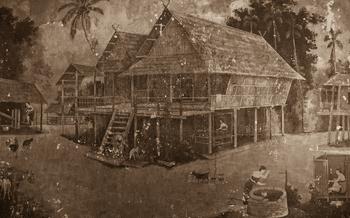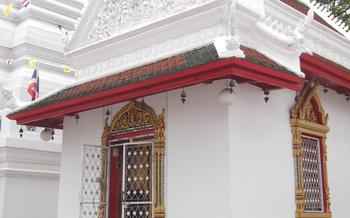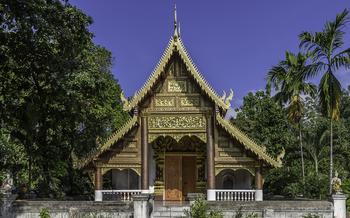
Wat Rong Ngae
- Historical Background: A Relic of the Past
- Architectural Marvels
- Reverence and Respect
- Visitor Experience
- Photographic Opportunities
- Local Cuisine: A Symphony of Flavors
- Souvenir Shopping
- Cultural Immersion: Embracing Local Traditions
- Accommodation Options
- Transportation
- Budgeting Tips
- Health and Safety
- Responsible Tourism
- Insider Tip: Unveil the Enchanting Wat Sri Muang
Historical Background: A Relic of the Past
Wat Rong Ngae, "The Temple of the Golden Bell," stands as a testament to the rich history and cultural heritage of Thailand. Built in the 15th century, the temple holds a prominent place in the annals of Phrae and is deeply entwined with the local community's spiritual and cultural identity.
The temple's unique architectural style, a blend of Lanna and Burmese influences, reflects the diverse cultural influences that have shaped Phrae's history. Its intricate murals and paintings, depicting scenes from Buddhist mythology and folklore, offer a glimpse into the beliefs and traditions of the people who have called this land home for centuries.
Legend has it that the temple was built by a wealthy merchant who, upon returning from a successful trading journey, decided to construct a magnificent temple as an act of gratitude. The merchant's generosity and devotion to Buddhism led to the construction of Wat Rong Ngae, which has since become a symbol of the town's prosperity and faith.
Architectural Marvels
Wat Rong Ngae stands as a testament to the architectural prowess of ancient artisans. Its intricate details and stunning design showcase the fusion of Lanna and Burmese styles, creating a truly unique and captivating structure. The temple's exterior is adorned with intricate carvings, sculptures, and colorful tiles that narrate tales from Buddhist mythology.
Inside the temple, visitors are greeted by an awe-inspiring sight: the walls and ceiling are adorned with exquisite murals and paintings that depict scenes from the life of Buddha, as well as stories from Thai folklore and mythology. These murals are not mere decorations; they serve as a visual representation of Buddhist teachings, offering a glimpse into the spiritual beliefs and values of the Lanna people.
The main Buddha image, known as Phra Phuttha Chinnarat, is a masterpiece of Lanna craftsmanship. Cast in bronze and adorned with gold leaf, the statue exudes an aura of serenity and compassion. Its delicate features, intricate robes, and serene expression have earned it widespread acclaim and made it one of the most revered Buddha images in Thailand.
Reverence and Respect
Wat Rong Ngae is a sacred place of worship for the local community, and visitors are expected to show respect and observe proper etiquette. When visiting the temple, it is essential to dress modestly, covering your shoulders and knees. Shoes should be removed before entering the temple grounds, and visitors should walk quietly and avoid causing any disturbance.
Offerings and donations are an important way to show your respect for the temple and support its upkeep. You can make offerings of flowers, candles, or incense, or donate money to the temple's donation box. When making an offering, be sure to do so with a sincere heart and with respect for the Buddha and the temple.
It is important to be mindful of your behavior and actions while visiting Wat Rong Ngae. Refrain from engaging in loud conversations or taking photos of the Buddha images without permission. Remember that the temple is a place of peace and tranquility, and it is important to respect the sanctity of the space.
By observing proper etiquette and showing respect, you can help preserve the sacredness of Wat Rong Ngae and ensure that future generations can continue to enjoy its beauty and spiritual significance.
Visitor Experience
Visiting Wat Rong Ngae offers a unique and immersive cultural experience. As you step through the temple gates, you'll be greeted by a sense of tranquility and serenity that envelops the grounds. The temple's peaceful atmosphere invites you to slow down, appreciate the beauty of your surroundings, and connect with your spiritual side.
Take your time to explore the temple's intricate details and artwork. Admire the stunning murals and paintings that adorn the walls, each telling a story from Buddhist mythology or depicting scenes from the life of Buddha. Pay attention to the symbolism and religious motifs depicted in the artwork, as they offer a deeper understanding of Buddhist beliefs and teachings.
Guided tours are available for those who want to learn more about the temple's history, architecture, and significance. Local guides can provide insights into the temple's unique features and customs, ensuring a more enriching experience. Whether you choose to explore independently or with a guide, Wat Rong Ngae offers a profound and memorable experience for visitors from all walks of life.
Photographic Opportunities
Wat Rong Ngae is a photographer's paradise, offering a multitude of picturesque views and photogenic spots. The temple's stunning architecture, intricate details, and serene atmosphere create a captivating backdrop for capturing unforgettable images.
Best Times to Photograph:
-
Early Morning: The soft, golden light of the early morning hours casts a warm glow on the temple's structures, creating a magical ambiance. This time of day is ideal for capturing the intricate details of the temple's architecture and the serene beauty of the surrounding gardens.
-
Late Afternoon: As the sun begins to set, the temple takes on a different character, with the warm hues of the setting sun casting long shadows and creating a dramatic effect. This time of day is perfect for capturing the temple's grandeur and the interplay of light and shadow.
Tips for Capturing the Essence:
-
Wide-Angle Lens: A wide-angle lens allows you to capture the temple's grandeur and the surrounding landscape in a single shot. This is especially useful for capturing the temple's impressive facades and the sprawling grounds.
-
Macro Lens: A macro lens allows you to capture the intricate details of the temple's sculptures, murals, and other decorative elements. This is a great way to showcase the craftsmanship and artistry that went into the temple's construction.
-
Tripod: A tripod is essential for capturing sharp and steady images, especially in low-light conditions. This is particularly important for capturing the temple's stunning sunsets and night scenes.
Local Cuisine: A Symphony of Flavors
A visit to Wat Rong Ngae is not complete without savoring the culinary delights of the region. Just a short walk from the temple, visitors can find a plethora of restaurants and street food stalls offering a tantalizing array of authentic Thai dishes. From aromatic curries to fresh seafood and mouthwatering noodles, the local cuisine is a feast for the senses.
Among the must-try dishes is the iconic Pad Thai, a stir-fried noodle dish with a harmonious balance of sweet, sour, and savory flavors. For a taste of the sea, indulge in the Tom Yum Goon, a spicy and sour soup bursting with the flavors of shrimp, lemongrass, and galangal. Another local favorite is Khao Soi, a rich and flavorful curry noodle soup with a unique blend of coconut milk and yellow curry paste.
For those seeking a vegetarian option, the Pad Pak Bung, a stir-fried morning glory with garlic and soy sauce, is a simple yet delicious dish. And for a sweet treat, try the Khanom Bueang, a crispy coconut pancake filled with sweet custard.
When dining in Thailand, it's important to embrace the local customs and etiquette. Meals are typically shared, so don't be surprised if your food arrives on communal plates. It's also customary to use a spoon and fork to eat, while chopsticks are reserved for noodle dishes.
By sampling the local cuisine, visitors can immerse themselves in the vibrant culinary culture of Phrae and create lasting memories of their visit to Wat Rong Ngae.
Souvenir Shopping
After exploring the wonders of Wat Rong Ngae, take some time to browse the nearby souvenir shops and local markets. These bustling marketplaces offer a treasure trove of unique souvenirs and handicrafts that will remind you of your visit to this sacred place.
Look for Buddha statuettes in various sizes and materials, from intricate bronze castings to serene carved wooden figures. These statuettes are not only beautiful decorative pieces but also hold deep spiritual significance for many Thai people.
Traditional Thai clothing, such as colorful silk scarves, handwoven cotton shirts, and elegant silk dresses, is another popular souvenir choice. These garments are not only stylish but also comfortable and breathable, making them perfect for the tropical Thai climate.
For a truly unique souvenir, consider purchasing a handmade item crafted by local artisans. These could include intricate silver jewelry, delicate bamboo crafts, or beautifully painted ceramic ware. Not only will you be taking home a one-of-a-kind piece, but you will also be supporting local artisans and businesses.
Remember, bargaining is an essential part of the shopping experience in Thailand. Don't be afraid to politely negotiate prices with vendors, but always do so respectfully and with a smile.
Cultural Immersion: Embracing Local Traditions
Wat Rong Ngae offers an immersive cultural experience that allows visitors to connect with the local way of life. Embrace the opportunity to attend vibrant festivals and events held at the temple, where you can witness traditional dance performances, listen to enchanting music, and savor delicious local cuisine. Engage with the resident monks, who are always willing to share their knowledge of Buddhism and Thai culture. Take the time to learn about their daily routines, their beliefs, and their practices. Whether it's participating in meditation sessions, receiving blessings, or simply engaging in conversations, these interactions will deepen your understanding of Thai culture and create lasting memories.
Accommodation Options
When planning your visit to Wat Rong Ngae, choosing the right accommodation is crucial to enhance your overall experience. The area surrounding the temple offers a range of lodging options, each with its own unique charm and amenities.
For those seeking a luxurious and indulgent stay, several upscale hotels and resorts are located within close proximity to the temple. These establishments offer top-notch facilities, such as swimming pools, spas, and fine dining restaurants, ensuring a comfortable and pampered stay.
Budget-conscious travelers can find a variety of affordable guesthouses and hostels near the temple. These accommodations provide basic yet comfortable rooms, allowing visitors to save money on lodging while still enjoying a pleasant and convenient stay.
If you prefer a more immersive experience, consider opting for a homestay with a local family. This unique accommodation option offers a glimpse into the everyday lives of the Thai people and an opportunity to learn about their culture and traditions.
When making your accommodation arrangements, consider factors such as your budget, desired level of comfort, and preferred travel style to choose the best option for your needs.
Transportation
Reaching Wat Rong Ngae is a breeze, thanks to the convenient transportation options available. From major cities like Bangkok or Chiang Mai, you can hop on a comfortable bus or train that will take you directly to Phrae. Once in Phrae, local buses or songthaews (shared taxis) can whisk you to the temple's doorstep.
For those who prefer a more scenic journey, renting a car or motorbike is an excellent option. The roads are well-maintained, and the drive offers stunning views of the countryside. Just remember to drive cautiously and obey local traffic regulations.
No matter your preferred mode of transport, getting to Wat Rong Ngae is a hassle-free experience. So, sit back, relax, and enjoy the ride as you embark on a journey to discover this architectural marvel.
Budgeting Tips
Visiting Wat Rong Ngae and the surrounding area doesn't have to break the bank. Here are some budget-friendly tips to help you make the most of your trip without sacrificing your experience:
-
Accommodation: Opt for budget-friendly guesthouses or hostels that offer clean and comfortable rooms at affordable rates. Consider staying in a dormitory-style room to save even more.
-
Transportation: Take advantage of the local transportation system, which is generally inexpensive and efficient. Buses and songthaews (shared taxis) are readily available and can take you to most places in the city.
-
Food: Sample the delicious street food, which is not only affordable but also a great way to experience local flavors. Many street stalls offer a variety of dishes at very reasonable prices.
-
Activities: Many attractions and activities in Phrae are free or low-cost. Explore the city's temples, markets, and museums, which often have no entrance fees. Take a walk or bike ride along the Yom River for a scenic and budget-friendly experience.
-
Souvenirs: Instead of buying expensive souvenirs at tourist shops, visit local markets or craft fairs to find unique and affordable handicrafts made by local artisans. Haggling is acceptable, so don't be afraid to negotiate for a better price.
Health and Safety
When exploring Thailand, it's essential to prioritize your health and safety. Here are some tips to ensure a smooth and enjoyable experience:
-
General Health: Stay hydrated by drinking plenty of bottled water and avoid tap water. Be cautious when consuming street food, as it may not be prepared under sanitary conditions. Consider getting travel insurance to cover any medical emergencies.
-
Scams and Tourist Traps: Be wary of common scams, such as tuk-tuk overcharging, fake tours, and gemstone scams. Always negotiate prices in advance and avoid unsolicited services or products.
-
Personal Safety: Keep your valuables safe by using a money belt or RFID-blocking wallet. Be aware of your surroundings, especially at night, and avoid walking alone in secluded areas. Respect local customs and dress modestly to avoid attracting unwanted attention.
-
Food and Water: Be mindful of what you eat and drink. Avoid raw or undercooked food, and choose fruits that you can peel yourself. Drink only bottled or boiled water to prevent waterborne illnesses.
-
Emergency Contacts: Keep important emergency contacts handy, including the Thai Tourist Police (1155) and your embassy or consulate.
Responsible Tourism
As you embark on your journey to Wat Rong Ngae, it's crucial to embrace responsible tourism practices. Respect the sanctity of the temple and the local culture by dressing modestly and adhering to the temple's dress code. Be mindful of noise levels and avoid disturbing the serene atmosphere of the temple grounds. Remember that photography is permitted, but always ask for permission before taking photos of monks or other visitors.
When purchasing souvenirs, opt for locally made handicrafts and products. This supports the local economy and preserves traditional craftsmanship. Engage with the locals respectfully and embrace the opportunity to learn about their way of life. Be mindful of your ecological footprint by reducing plastic waste and conserving water and energy. By practicing responsible tourism, you contribute to the sustainability of the region and ensure that future generations can continue to cherish this sacred site.
Insider Tip: Unveil the Enchanting Wat Sri Muang
Just a short distance from Wat Rong Ngae lies a hidden gem known only to locals—the enchanting Wat Sri Muang. This lesser-known temple boasts a unique charm and tranquility that will captivate your senses. Its serene atmosphere and intricate architecture create a mystical ambiance that transports you back in time.
To reach Wat Sri Muang, follow the narrow path that leads from Wat Rong Ngae's main entrance. As you approach the temple, you'll be greeted by a majestic chedi adorned with intricate carvings and vibrant colors. Take your time to admire the exquisite craftsmanship and the serene surroundings before stepping inside.
Inside the temple, you'll discover a sanctuary of peace and spirituality. The walls are adorned with vibrant murals depicting scenes from the life of Buddha and Thai folklore. The air is filled with the gentle chanting of monks and the soft glow of flickering candles. Spend a moment here to meditate, reflect, and soak in the temple's sacred energy.
Wat Sri Muang is a hidden gem that offers a glimpse into the rich cultural heritage of Phrae. Its serene atmosphere and stunning architecture make it a must-visit for those seeking a truly authentic and spiritual experience. Remember to respect the temple's sanctity and dress appropriately when visiting.




